2014 Peugeot 308 fuel
[x] Cancel search: fuelPage 4 of 389
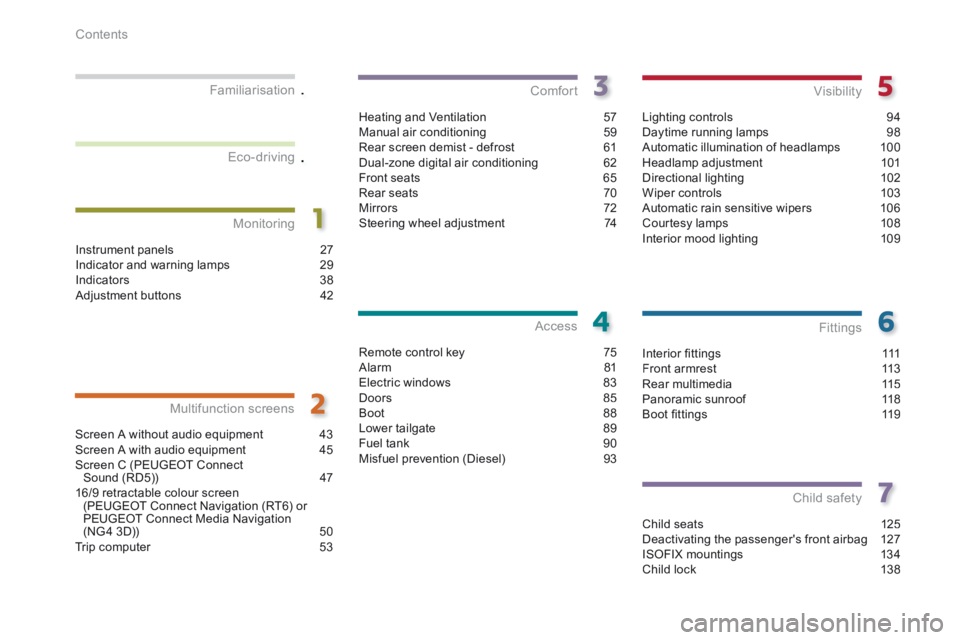
.
.
Contents
Interior fi ttings 111Front armrest 113Rear multimedia 115Panoramic sunroof 118Boot fi ttings 119
Fittings
Child seats 125Deactivating the passenger's front airbag 127ISOFIX mountings 134Child lock 138
Child safety
Instrument panels 27Indicator and warning lamps 29Indicators 38Adjustment buttons 42
Monitoring
Familiarisation
Screen A without audio equipment 43Screen A with audio equipment
45Screen C (PEUGEOT Connect Sound (RD5)) 4716/9 retractable colour screen (PEUGEOT Connect Navigation (RT6) or PEUGEOT Connect Media Navigation (NG4 3D)) 50Trip computer 53
Multifunction screens
Heating and Ventilation 57Manual air conditioning 59Rear screen demist - defrost 61Dual-zone digital air conditioning 62Front seats 65Rear seats 70Mirrors 72Steering wheel adjustment 74
Comfort
Remote control key 75Alarm 81Electric windows 83Doors 85Boot 88Lower tailgate 89Fuel tank 90Misfuel prevention (Diesel) 93
Access
Lighting controls 94Daytime running lamps 98Automatic illumination of headlamps 100Headlamp adjustment 101Directional lighting 102Wiper controls 103Automatic rain sensitive wipers 106Courtesy lamps 108Interior mood lighting 109
Visibility
Eco-driving
Page 5 of 389
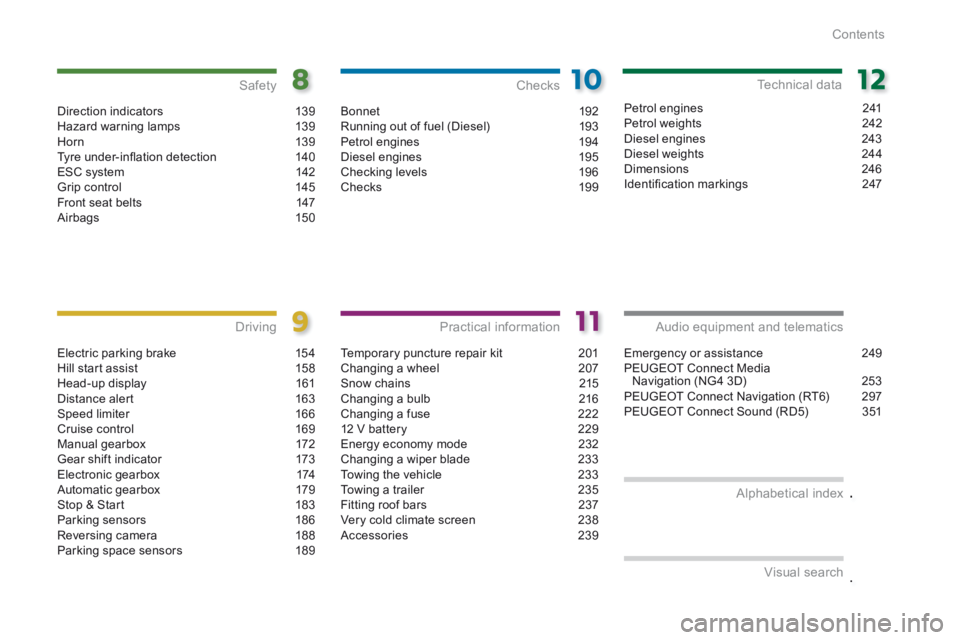
.
.
Contents
Direction indicators 139Hazard warning lamps 139H or n 13 9Tyre under-infl ation detection 140ESC system 142Grip control 145Front seat belts 147Airbags 150
Safety
Electric parking brake 154Hill start assist 158Head-up display 161Distance alert 163Speed limiter 166Cruise control 169Manual gearbox 172Gear shift indicator 173Electronic gearbox 174Automatic gearbox 179Stop & Start 183Parking sensors 186Reversing camera 188Parking space sensors 189
Driving
Emergency or assistance 249PEUGEOT Connect Media Navigation (NG4 3D) 253PEUGEOT Connect Navigation (RT6) 297PEUGEOT Connect Sound (RD5) 351
Audio equipment and telematics
Visual search
Alphabetical index
Bonnet
192Running out of fuel (Diesel) 193Petrol engines 194Diesel engines 195Checking levels 196Checks 19 9
Checks
Temporary puncture repair kit 201Changing a wheel 207Snow chains 215Changing a bulb 216Changing a fuse 22212 V battery 229Energy economy mode 232Changing a wiper blade 233Towing the vehicle 233Towing a trailer 235Fitting roof bars 237Very cold climate screen 238Accessories 239
Practical information
Petrol engines 241Petrol weights 242Diesel engines 243Diesel weights 244Dimensions 246Identifi cation markings 247
Technical data
Page 6 of 389
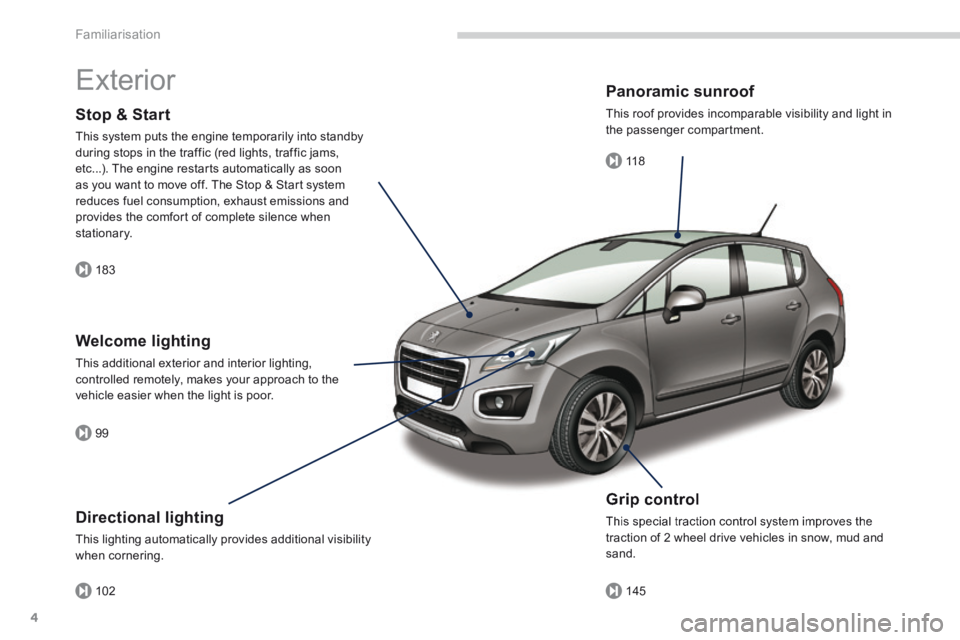
183
99
102
11 811 8
145
Familiarisation
4
Exterior
Grip control
This special traction control system improves the traction of 2 wheel drive vehicles in snow, mud and sand.
Welcome lighting
This additional exterior and interior lighting, controlled remotely, makes your approach to the vehicle easier when the light is poor.
Directional lighting
This lighting automatically provides additional visibility when cornering.
Panoramic sunroof
This roof provides incomparable visibility and light in the passenger compartment. Stop & Start
This system puts the engine temporarily into standby during stops in the traffic (red lights, traffic jams, etc...). The engine restarts automatically as soon as you want to move off. The Stop & Start system reduces fuel consumption, exhaust emissions and reduces fuel consumption, exhaust emissions and provides the comfort of complete silence when
stationary.
Page 8 of 389
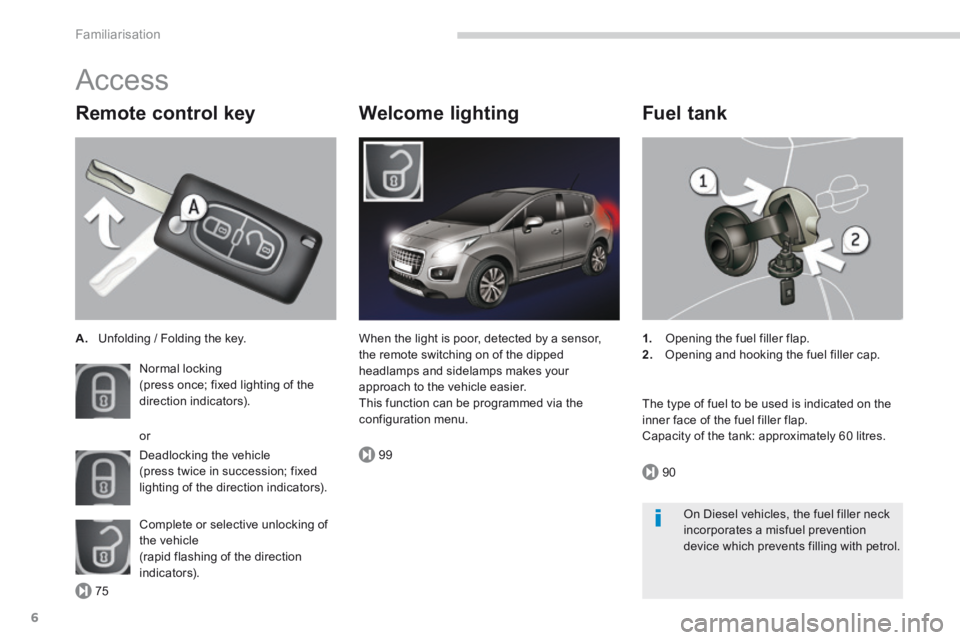
75
99
90
Familiarisation
6
Remote control key
A. Unfolding / Folding the key.
Normal locking (press once; fixed lighting of the direction indicators).
Deadlocking the vehicle (press twice in succession; fixed lighting of the direction indicators).
Complete or selective unlocking of the vehicle (rapid flashing of the direction i n di c ato r s).
or
When the light is poor, detected by a sensor, the remote switching on of the dipped headlamps and sidelamps makes your approach to the vehicle easier. This function can be programmed via the configuration menu.
Fuel tank
1. Opening the fuel filler flap. 2. Opening and hooking the fuel filler cap.
The type of fuel to be used is indicated on the inner face of the fuel filler flap. Capacity of the tank: approximately 60 litres.
Welcome lighting
On Diesel vehicles, the fuel filler neck incorporates a misfuel prevention device which prevents filling with petrol.
Access
Page 18 of 389
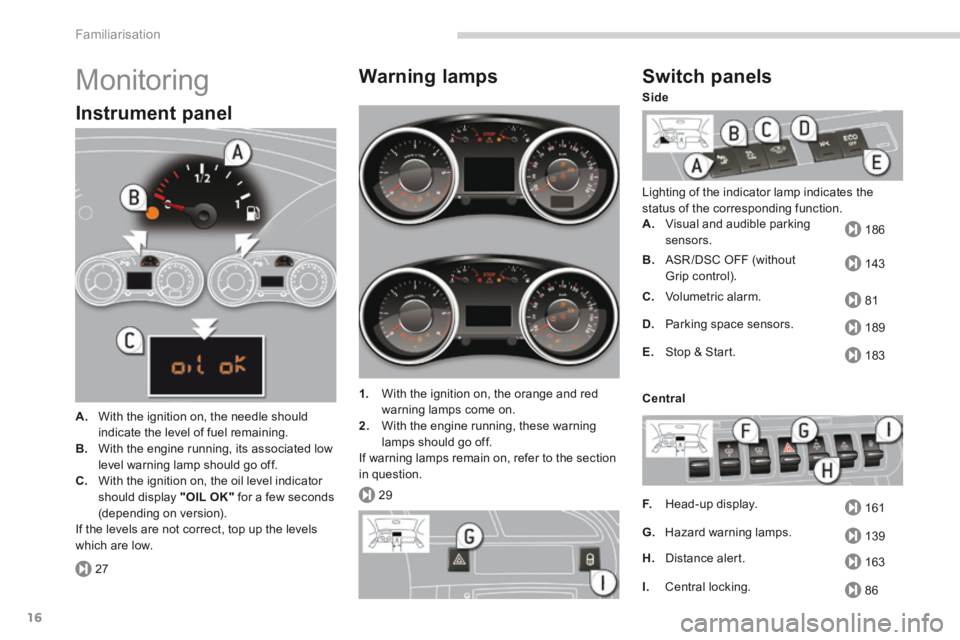
27
29
186
143
81
189
183
161
139
163
86
Familiarisation
16
Monitoring
Instrument panel
A. With the ignition on, the needle should
indicate the level of fuel remaining. B. With the engine running, its associated low level warning lamp should go off. C. With the ignition on, the oil level indicator should display "OIL OK" for a few seconds (depending on version). If the levels are not correct, top up the levels which are low.
Warning lamps
1. With the ignition on, the orange and red warning lamps come on. 2. With the engine running, these warning lamps should go off. If warning lamps remain on, refer to the section in question.
Switch panels
Lighting of the indicator lamp indicates the status of the corresponding function. A. Visual and audible parking sensors.
B. ASR /DSC OFF (without Grip control).
C. Volumetric alarm.
D. Parking space sensors.
E. Stop & Start.
F. Head-up display.
G. Hazard warning lamps.
H. Distance alert.
Side
Central
I. Central locking.
Page 22 of 389
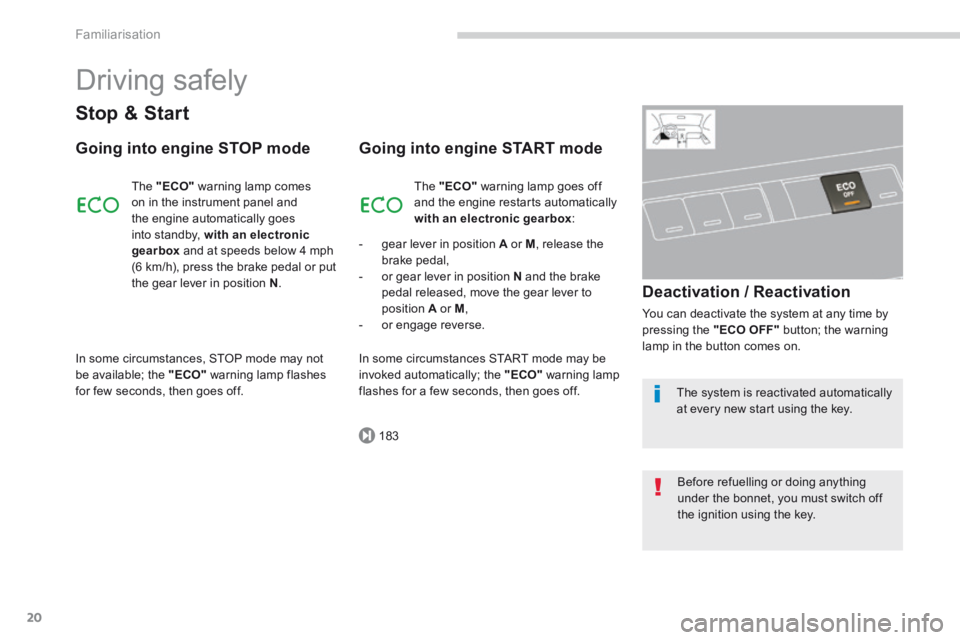
183
Familiarisation
20
Driving safely
Stop & Start
Going into engine STOP mode
The "ECO" warning lamp comes on in the instrument panel and the engine automatically goes
into standby, with an electronic gearbox and at speeds below 4 mph (6 km/h), press the brake pedal or put the gear lever in position N .
Going into engine START mode
Deactivation / Reactivation
You can deactivate the system at any time by pressing the "ECO OFF" button; the warning lamp in the button comes on.
The "ECO" warning lamp goes off and the engine restarts automatically with an electronic gearbox :
- gear lever in position A or M , release the brake pedal, - or gear lever in position N and the brake pedal released, move the gear lever to position A or M , - or engage reverse.
In some circumstances, STOP mode may not be available; the "ECO" warning lamp flashes for few seconds, then goes off.
In some circumstances START mode may be invoked automatically; the "ECO" warning lamp flashes for a few seconds, then goes off. The system is reactivated automatically at every new start using the key.
Before refuelling or doing anything under the bonnet, you must switch off the ignition using the key.
Page 27 of 389

.Familiarisation25
Optimise the use of your
gearbox
With a manual gearbox, move off gently and change up without waiting. During acceleration change up early.
With an automatic or electronic gearbox, give preference to automatic mode and avoid pressing the accelerator pedal heavily or suddenly.
The gear shift indicator invites you engage the most suitable gear: as soon as the indication is displayed in the instrument panel, follow it straight away. With an electronic or automatic gearbox, this indicator appears only in manual mode.
Drive smoothly
Maintain a safe distance between vehicles, use engine braking rather than the brake pedal, and press the accelerator progressively. These practices contribute towards a reduction in fuel consumption and CO2 emissions and also helps reduce the background traffic noise.
If your vehicle has cruise control, make use of the system at speeds above 25 mph (40 km/h) when the traffic is flowing well.
Control the use of your
electrical equipment
Before moving off, if the passenger compartment is too warm, ventilate it by opening the windows and air vents before using the air conditioning. Above 30 mph (50 km/h), close the windows and leave the air vents open. Remember to make use of equipment that can help keep the temperature in the passenger compartment down (sunroof and window blinds...).
Switch off the headlamps and front foglamps when the level of light does not require their use.
Avoid running the engine before moving off, particularly in winter; your vehicle will warm up much faster while driving.
Eco-driving
Eco-driving is a range of everyday practices that allow the motorist to optimise their fuel consumption and CO2 emissions.
As a passenger, if you avoid connecting your multimedia devices (film, music, video game...), you will contribute towards limiting the consumption of electrical energy, and so of fuel. Disconnect your portable devices before leaving the vehicle.
Switch off the air conditioning, unless it has automatic regulation, as soon as the desired temperature is attained. Switch off the demisting and defrosting controls, if not automatic. Switch off the heated seat as soon as possible.
Page 28 of 389

Familiarisation
26
Limit the causes of excess
consumption
Spread loads throughout the vehicle; place the heaviest items in the bottom of the boot, as close as possible to the rear seats. Limit the loads carried in the vehicle and reduce wind resistance (roof bars, roof rack, bicycle carrier, trailer...). Use a roof box in preference. Remove roof bars and roof racks after use.
At the end of winter, remove snow tyres and refit your summer tyres.
Observe the recommendations
on maintenance
Check the tyre pressures regularly, when cold, referring to the label in the door aperture, driver's side.
Have your vehicle serviced regularly (engine oil, oil filter, air filter...) and observe the schedule of operations recommended by the manufacturer.
When refuelling, do not continue after the third cut-off of the nozzle to avoid any over flow.
At the wheel of your new vehicle, it is only after the first 1 800 miles (3 000 kilometres) that you will see the fuel consumption settle down to a consistent average.
Carry out this check in particular: - before a long journey, - at each change of season, - after a long period out of use. Don't forget the spare wheel and the tyres on any trailer or caravan.